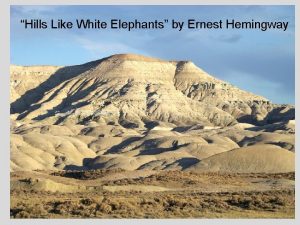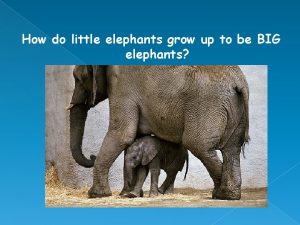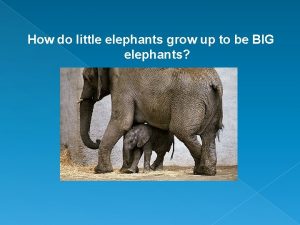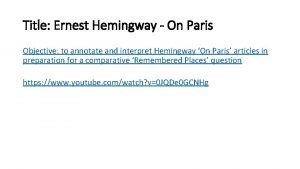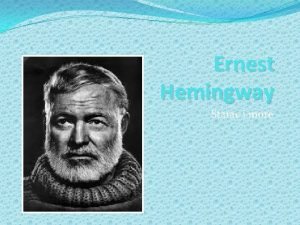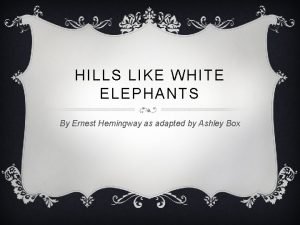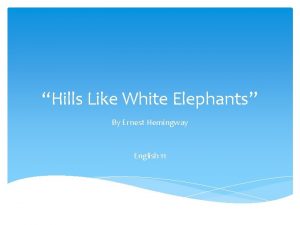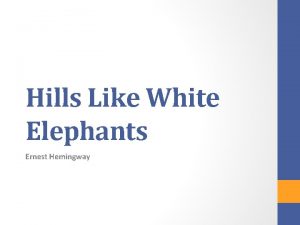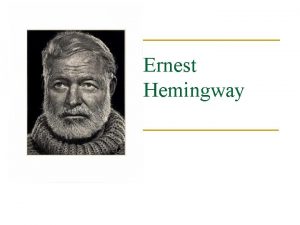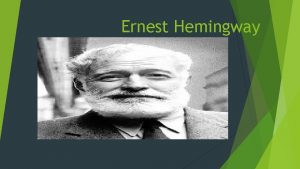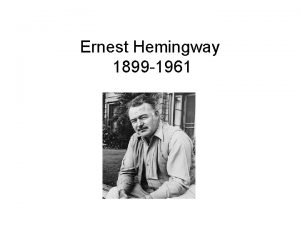Short Stories Hills Like White Elephants Ernest Hemingway










- Slides: 10

Short Stories

Hills Like White Elephants Ernest Hemingway

Summary of the Plot • The story opens on a railway station in Spain where the train is expected in 40 minutes. A man referred to as “the American” and his girl, Jig, sit at a table outside the station’s bar. The landscape surrounding the station is described as the valley of the Ebro River, with long white hills on each side and brown dusty ground in between. Jig remarks that the hills look like white elephants. • The story ends with the couple expecting their train’s arrival in five minutes. There is no resolution and there is no decision stated regarding the operation they were discussing. • The text shows by the girl’s comments that he has been making her miserable in his desire for her to have the operation even though he claims it is all for her sake. She clearly does not wish to continue this conversation. • This story was not only intended for the pleasures of reading, but also though provocation. Hemingway has intentionally left the readers to conclude for themselves what will happen next.

Characters • The Girl (Jig): – The protagonist of "Hills Like White Elephants, " the girl who is waiting with the American for the train to Madrid. She fears her pregnancy has irrevocably changed her relationship with the American and is wary about having the abortion, and she fences verbally with him about it, signaling a tug-of-war between the two in which she holds some of the cards but is well aware that her adversary holds the rest. – The girl is at a crossroads within her own life. She is now reflecting on the idea that every decision that she, or perhaps he, makes alters their future. She feels as if she is losing something that she will not be able to get back once it is gone. – Compared to the American, Hemingway’s overly masculine character, the girl is less assertive and persuasive. – Throughout the story, the girl appears helpless, confused, and indecisive. She changes her mind about the attractiveness of the surrounding hills, for example; claims to selflessly care only for the American; and seems uncertain about whether she wants to have the operation. In fact, the girl can’t even order drinks from the bartender on her own without having to rely on the man’s ability to speak Spanish. – Ironically, the girl seems to understand that her relationship with the American has effectively ended, despite her professed desire to make him happy. She knows that even if she has the operation, their relationship won’t return to how it used to be. In many ways, the girl’s realization of this fact gives her power over the American, who never really understands why they still can’t have “the whole world” like they once did.

• The American Characters – The implied father of Jig’s child in "Hills Like White Elephants" who is waiting with her for the train to Madrid. He is pestering her to have the abortion and betrays his anxiety in myriad ways but gives lip service to the fact he still loves her and will love her even if she does not have it. – He is aware that he holds over her the ability to end their relationship or to make it emotionally hostile for her, but he is also aware that he is very much on the hook if she decides to forgo the abortion. – Throughout the story, the American behaves according to Hemingway’s rigid conception of masculinity. Hemingway portrays the American as a rugged man’s man—knowledgeable, worldly, and always in control of himself and the situation at hand. Even when vexed or confused, he maintains his cool and feigns indifference, such as when he tells the girl he doesn’t care whether she has the operation. – He initially avoids discussion of their problems, but when pressured, he tackles them head on by oversimplifying the operation and relentlessly pushing her to have it. Thinking himself to be the more reasonable of the two, he patronizes the girl and fails to provide the sympathy and understanding she needs during the crisis. – Uncompromising, he seems to identify more with the other passengers “waiting reasonably” at the station than with his own girlfriend at the end of the story, which suggests that the two will go their separate ways.

Themes Talking versus Communicating: Although “Hills Like White Elephants” is primarily a conversation between the American man and his girlfriend, neither of the speakers truly communicates with the other, highlighting the rift between the two. Both talk, but neither listens or understands the other’s point of view. The girl’s inability to speak Spanish with the bartender, moreover, not only illustrates her dependence on the American but also the difficulty she has expressing herself to others. The power of nature, both in terms of its beauty and its challenges, to improve one’s quality of life. – Jig looks to the beauty of the Ebro River valley for guidance as to whether or not she should have the operation. • Ambivalence: – Many of Hemingway’s characters have undecided feelings toward each other; in Hemingway’s universe, people are not wholly good or bad. – Jig feels resentful toward her partner, who is insisting that she have an operation, but at the same time she wants to repair her relationship with him, which has suffered because of the pregnancy. She weighs his promise that their relationship will go back to the way it was before if she has the operation with her own reluctance to get the procedure and certainty that their relationship has been changed just by the pregnancy.

Setting • From the first paragraph the setting immediately introduces the tense atmosphere that will surround the rest of the story. • The story takes place in Spain in the late 1920’s. The setting is described as follows: • The hills across the valley of the Ebro were long and white. On this side there was no shade and no trees and the station was between two lines of rails in the sun. […] The American and the girl with him sat at a table in the shade, outside the building. It was very hot and the express from Barcelona would come in forty minutes. It stopped at this junction for two minutes and went to Madrid.

Setting • The couple is in the • middle of making • a drastic decision • where there are only two choices, two directions, just like the two rail lines that pass by the station. The openness and loneliness around the railroad station imply that there is no way to back out of the problem at hand that the man and the girl must address it now.

Symbolism • The landscape that encompasses the station plays a fundamental role in the conflict of the story through its extensive symbolism. • The setting is cut in half by a railroad and train station. On one side the landscape is fertile and the other barren and dry. The landscape represents either outcome: motherhood or abortion and the train junction embodies the possibility of either or, in other words the choice. – When the girl sees the long and white hills she says that “they look like white elephants. ” As she observes the white hills she foresees elatedly the birth of her baby – something unique like the uncommon white elephant. The color white symbolizes the innocence and purity of her unborn child. – The fields of grain, the trees and the river represent fertility and fruitfulness, which symbolize her current pregnant state. – Just as the girl appreciates the panorama and its connection to her unborn child the “shadow of a cloud, ” which represents the abortion of the fetus, overcomes her happiness. – The man is obviously in favor of the abortion, and everything he says is an effort to persuade her into it. As she considers his point of view she looks at the dry side of the valley, which is barren and sterile. – The bags with all the hotel labels on them are symbolic of his vivacious spirit. If the woman goes ahead with the pregnancy, he would have to settle down and raise a family, which would mean forgoing his desires of seeing the world.

• The title of the story has led many to speculate on what the “white elephant” symbolizes for the couple. A white elephant is generally thought of as unusual and cumbersome, in short, a problem. Most scholars believe it means that the white elephant is the baby/pregnancy (the obvious choice) or the American himself, given his bullying of Jig. • Hemingway utilizes the setting to lead the reader to the idea that the hills resemble a woman's pregnant stomach. • In India's past a white elephant was considered a great status symbol but if one was not able to maintain it, this status symbol could ruin its owner.
 Hills like white elephants protagonist
Hills like white elephants protagonist Questions about hills like white elephants
Questions about hills like white elephants Hills like white elephants page count
Hills like white elephants page count Long and short
Long and short How do little elephants grow up to be big elephants
How do little elephants grow up to be big elephants How do little elephants grow up to be big elephants
How do little elephants grow up to be big elephants On paris ernest hemingway analysis a level
On paris ernest hemingway analysis a level Invictus is all about
Invictus is all about Starec a more
Starec a more Starac i more ernest hemingway
Starac i more ernest hemingway Starac i more
Starac i more

